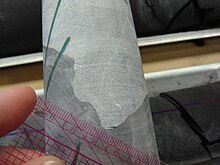



Sole marks are sedimentary structures found on the bases of certain strata, that indicate small-scale (usually on the order of centimetres) grooves or irregularities.[1][2] This usually occurs at the interface of two differing lithologies and/or grain sizes. They are commonly preserved as casts of these indents on the bottom of the overlying bed (like flute casts). This is similar to casts and molds in fossil preservation. Occurring as they do only at the bottom of beds, and their distinctive shapes, they can make useful way up structures and paleocurrent indicators.[3]
Sole markings are found most commonly in turbidite deposits, but are also often seen in modern river beds and tidal channels.
- ^ http://course1.winona.edu/csumma/FieldTrips/SedimentaryStructures/sole%5Fmarks/ Sole Marks
- ^ Bates, R. L. and Jackson, J. A., 1984, Dictionary of Geologic Terms
- ^ Prothero, D. R. and Schwab, F., 1996, Sedimentary Geology, pg. 55, ISBN 0-7167-2726-9
